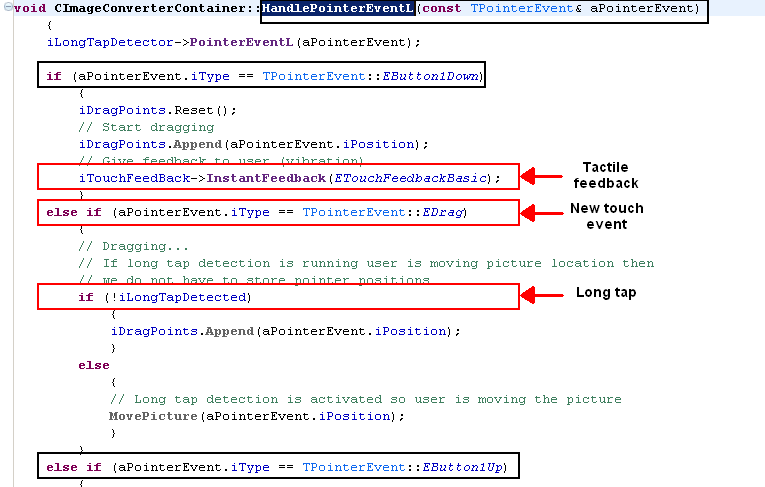Handling pointer events in custom controls
The Symbian platform passes touch events to applications by calling CCoeControl::HandlePointerEventL(). The application that receives these events is the one that owns the window.
While this method has been available since S60 3.0, it previously has been an optional method. If you have derived a custom control from CCoeControl, then you must implement the CCoeControl::HandlePointerEventL() method. Otherwise, your application cannot react to the touch events passed to it.
You have to implement at least CCoeControl::HandlePointerEventL() into your own custom UI components. If you have a container control that owns other controls, you have to remember to call the base class implementation of CCoeControl::HandlePointerEventL() before your additional code as illustrated below:
void CMyContainerControl::HandlePointerEventL()
{
// Remember to call base class implementation
CCoeControl::HandlePointerEventL();
// Your additional code here
// ...
}
The following figure illustrates changes in the code. Items marked with a black frame indicate usage of features in earlier editions, and items marked with a red frame are new features.
To handle pointer events in your custom control:
In your custom control header file, include the CCoeControl::HandlePointerEventL() method.
public: // from CCoeControl void HandlePointerEventL(const TPointerEvent& aPointerEvent);In your custom control, implement the CCoeControl::HandlePointerEventL() method.
void CMyControl::HandlePointerEventL(const TPointerEvent& aPointerEvent) { switch( aPointerEvent.iType ) { case TPointerEvent::EButton1Up: { // Is the pointer position on this component? if (Rect().Contains(aPointerEvent.iPosition)) { SetFocus(ETrue); // Tell container control that this is focused control CMyContainerControl* parent = static_cast<CMyContainerControl*>(Parent()); parent->SetLastFocusedControl(this); } break; } default: { break; } } }By default, the Symbian platform only passes EButton1Down and EButton1Up events to CCoeControl::HandlePointerEventL(). To enable drag events, see Enabling additional touch events for your application.
In your custom container control header file, include the CCoeControl::HandlePointerEventL() method.
void HandlePointerEventL(const TPointerEvent& aPointerEvent);
In your custom container control, implement the CCoeControl::HandlePointerEventL() method.
void CMyContainerControl::HandlePointerEventL(const TPointerEvent& aPointerEvent) { // Check if touch is enabled or not if( !AknLayoutUtils::PenEnabled() ) { return; } // Remove last focus if (iLastFocusedControl) { iLastFocusedControl->SetFocus(EFalse); } // Call base class method, that forwards pointer event the right child // component CCoeControl::HandlePointerEventL(aPointerEvent); // Check all button up cases again if (aPointerEvent.iType == TPointerEvent::EButton1Up) { // Find which control was focused / received pointer event CCoeControlArray::TCursor cursor = Components().Begin(); CCoeControl* ctrl = NULL; TInt counter = 0; while ((ctrl = cursor.Control<CCoeControl>()) != NULL) { if (ctrl->Rect().Contains(aPointerEvent.iPosition)) { // Set focused index for the scroll bar iFocusedIndex = counter; break; } cursor.Next(); counter++; } } // Do drawing UpdateScrollBarFrameL(); DrawNow(); }Note:For information on the AknLayoutUtils::PenEnabled() method, see Checking for touch support at runtime.
Features introduced:
Optional TPointerEvent::EDrag() for receiving events indicating that a mobile device user is dragging it across the screen.
For more information on this and other touch event options, see Enabling additional touch events for your application.
Optional MTouchFeedback observer for sending a vibration when a mobile device user touches a control with the feedback interface.
For more information on tactile feedback, see Tactile feedback.
Copyright ©2010 Nokia Corporation and/or its subsidiary(-ies).
All rights
reserved. Unless otherwise stated, these materials are provided under the terms of the Eclipse Public License
v1.0.
